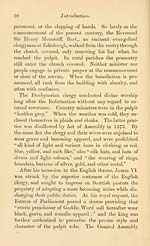Grampian Club > Scotland, social and domestic
(25) Page 19
Download files
Complete book:
Individual page:
Thumbnail gallery: Grid view | List view

Introduction. 19
their meeting on the 30th August, 1643, heard the
report of two of the brethren, who had been appointed
in a certain inquisitorial piece of business. The minute
proceeds thus : —
" Mr. David Forrett shew that he and Mr. John
Barron were at the house of Pitcullo, and declares there
are upon the frontispiece of the house some monu-
ment of superstition. The presbytery appoints a letter
to be .written to the Lord Burghley, in treating him to
give orders for demolishing all monuments of the kind."
No doubt. Lord Burghley had to part with the sculp-
tured tablet on the front of his mansion.
During the seventeenth and eighteenth centuries
churches were erected without any semblance of orna-
ment ; and the sculptures and ornaments of the older
structures were buried in the walls. The larger stones,
which had formed altar-pieces, or been connected with
the ancient tombs, were used as pavement. From those
edifices which had escaped destruction, carved entab-
latures, niches, pinnacles, and mullions were carefully
removed. Pillars and groined arches were besmeared
with plaster and otherwise discoloured.
The Reformers abhorred the idea of consecrated
places ; they encouraged the people to enter places
of worship with their heads covered. For nearly two
centuries after the Reformation, the male members of
every congregation sat on the forms, or in the pews,
with their hats on till the minister entered the pulpit
and announced the opening psalm. They remained
uncovered during praise and prayer, but when the
text was announced they resumed their hats. When
the minister in his discourse said anything uncom-
monly striking, he was applauded by a beating on the
their meeting on the 30th August, 1643, heard the
report of two of the brethren, who had been appointed
in a certain inquisitorial piece of business. The minute
proceeds thus : —
" Mr. David Forrett shew that he and Mr. John
Barron were at the house of Pitcullo, and declares there
are upon the frontispiece of the house some monu-
ment of superstition. The presbytery appoints a letter
to be .written to the Lord Burghley, in treating him to
give orders for demolishing all monuments of the kind."
No doubt. Lord Burghley had to part with the sculp-
tured tablet on the front of his mansion.
During the seventeenth and eighteenth centuries
churches were erected without any semblance of orna-
ment ; and the sculptures and ornaments of the older
structures were buried in the walls. The larger stones,
which had formed altar-pieces, or been connected with
the ancient tombs, were used as pavement. From those
edifices which had escaped destruction, carved entab-
latures, niches, pinnacles, and mullions were carefully
removed. Pillars and groined arches were besmeared
with plaster and otherwise discoloured.
The Reformers abhorred the idea of consecrated
places ; they encouraged the people to enter places
of worship with their heads covered. For nearly two
centuries after the Reformation, the male members of
every congregation sat on the forms, or in the pews,
with their hats on till the minister entered the pulpit
and announced the opening psalm. They remained
uncovered during praise and prayer, but when the
text was announced they resumed their hats. When
the minister in his discourse said anything uncom-
monly striking, he was applauded by a beating on the
Set display mode to: Large image | Transcription
Images and transcriptions on this page, including medium image downloads, may be used under the Creative Commons Attribution 4.0 International Licence unless otherwise stated. ![]()
| Publications by Scottish clubs > Grampian Club > Scotland, social and domestic > (25) Page 19 |
|---|
| Permanent URL | https://digital.nls.uk/81896984 |
|---|
| Description | Note: Numbers 24-41 are relative to but not part of the Club's series. |
|---|---|

